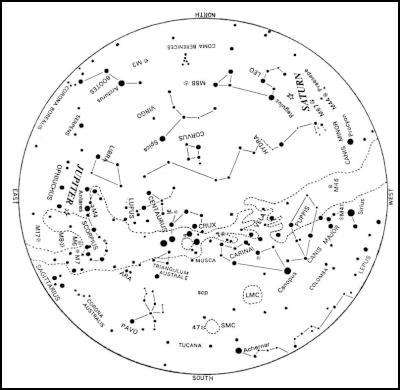The May Night Sky
The Night Sky
Brian Carter *Carter Observatory
The National Observatory Of New Zealand
THE MAY NIGHT SKY
Nights are getting colder and longer for looking at the stars and planets.
Planets
May is a good month for viewing the planets. Venus, Mars, Jupiter and Saturn will be visible for all of the month. Mercury will be visible towards the end of the month.
Venus will be visible in the evening sky. At the start of the month it sets at 19 35 and at 20 08 by month’s end. Venus starts the month in the constellation of Taurus, moving into Gemini on May 10. Its brilliant magnitude slightly increases from –4.1 to –4.2 during May.
Saturn will be visible for the first half of the night. At the start of the month it sets at 00 16 and at 22 21 by month’s end. Saturn is in the constellation of Leo, in which it remains until September 2009. Its magnitude slightly fades from 0.4 to 0.5 during the month.
Jupiter will be visible for all of the night except at the start of the night at the beginning of May. At the start of the month it rises at 19 29 and at 17 19 by month’s end. Jupiter is in the constellation of Ophiuchus, in which it remains until 2007 December. Its magnitude slightly increases from –2.5 to –2.6, it’s brightest for the year.
Mars will be visible for the last quarter of the night. At the start of May it rises at 02 45 and at 02 42 by month’s end. Mars start the month in the constellation of Aquarius, moving into Pisces on May 10, into Cetus on May 25 and finally back into Pisces on May 30. Its magnitude slightly brightens from 1.0 to 0.9 during the month.
Mercury will be visible in the evening sky towards the end of May. By May 22 it sets at 18 05, an hour after Sunset and at 18 24 by month’s end. Mercury starts the month in the constellation of Aries, moving into Taurus on May 10 and finally into Gemini on May 30. From May 22 its magnitude fades from –0.5 to 0.3.
All times are for Wellington unless otherwise stated. Other centres may vary by a few minutes.
Phases of the Moon
Full Moon –
May 2 at 22 09.
Last Quarter – May 10 at 16 27.
New
Moon – May 17 at 07 27.
First Quarter – May 24 at 09
03.
Diary of Astronomical Phenomena
May 2 Full Moon
at 22 09.
3 Mercury in Superior Conjunction (on far side
of Sun ) at 16 00.
5 Antares very close to Moon just
before Sunrise.
6 Jupiter 6°N of Moon at 00
00.
16 Moon at perigee (closest to the Earth) at 03:00.
(Distance = 0.0024024 AU = 359,390 km).
17 New Moon at 07
27.
28 Moon at apogee (furthest from the Earth) at 10:00
(Distance = 0.0027103 AU = 405,460 km).
30/31 Venus close
to Pollux in the evening sky.
MAY SKY CHART
This chart shows the sky as it appears at about 21:00 for ~May 15.

Click to enlarge
How To Use the Sky
Charts
To use the sky chart hold it up to the sky so that
the direction in which you are looking is at the lower edge
of the map. For example, if you are looking at the western
horizon then the map should be held so that the “WEST”
label is at the lower edge. The altitude and direction of
the stars and planets will then be correctly shown. The
centre of the chart will be directly overhead.
* Brian Carter is the Senior Astronomer at Carter Observatory (The National Observatory of New Zealand), PO Box 2909, Wellington. (Observatory Web Site: www.CarterObservatory.org)


 DC Harding: In The Spirit Of Natural Justice
DC Harding: In The Spirit Of Natural Justice Martin LeFevre - Meditations: Animal Encounters During Meditative States
Martin LeFevre - Meditations: Animal Encounters During Meditative States Ian Powell: Gisborne Hospital Senior Doctors Strike Highlights Important Health System Issues
Ian Powell: Gisborne Hospital Senior Doctors Strike Highlights Important Health System Issues Keith Rankin: Who, Neither Politician Nor Monarch, Executed 100,000 Civilians In A Single Night?
Keith Rankin: Who, Neither Politician Nor Monarch, Executed 100,000 Civilians In A Single Night? Eugene Doyle: Writing In The Time Of Genocide
Eugene Doyle: Writing In The Time Of Genocide Gordon Campbell: On Wealth Taxes And Capital Flight
Gordon Campbell: On Wealth Taxes And Capital Flight